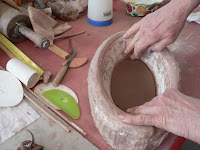 |
| cutting out the patterns |
 |
| bevelling the edge |
(this is the second part;
part one is here)
Once I've tested the patterns with an actual clay trial form, and know that the patterns are going to work, I roll out a clay slab, flipping the slab over each time I roll it. To keep the slab even, I use two 1/4 inch dowels on either side, like train tracks, on which the rolling pin can roll. The table surface is a piece of granite, smooth, and slightly absorbant. The sheeting (part polyester--doesn't wrinkle as much....) makes it easier to lift the slab, each time it's rolled out, so that I can flip it over before I roll it out, again. Then I cut as many forms out of one slab as I can fit--I hate having to recycle the slabs if I don't have to! The oval base goes into the bottom of the plaster mold, and its outer edges are pressed and thinned once the base is in place. The side pieces get a bevel cut at each end, where the ends will overlap each other. The top edge of the curved side piece is smoothed, now, as well.
 |
| placing the cut shapes into the mold |
Once all the pieces are in place, (I scrub the areas to be joined with a toothbrush dipped in vinegar) they're smoothed down, and pressed against the bottom and side with my fingers. I also put a soft coil around the oval, at the inside base of the piece, and up the sides at
the joining of the two sides.
 |
| fitting the side pieces on top of the base |
Then I dip a small blue (or red) rubber rib into water, and smooth all of the inside. The top edge is smoothed, again, with a chamois, and the the top edge is fluted. At this point, I have to let the piece dry out enough so that it can be lifted out of the mold. If I'm done working for the day, then I cover the mold and clay form with a sheet of plastic, and come back to it in the morning. Otherwise, I can let it sit out for a while until the wet/leatherhard clay will release from the plaster.
Final work on this piece will continue in a third post.


















